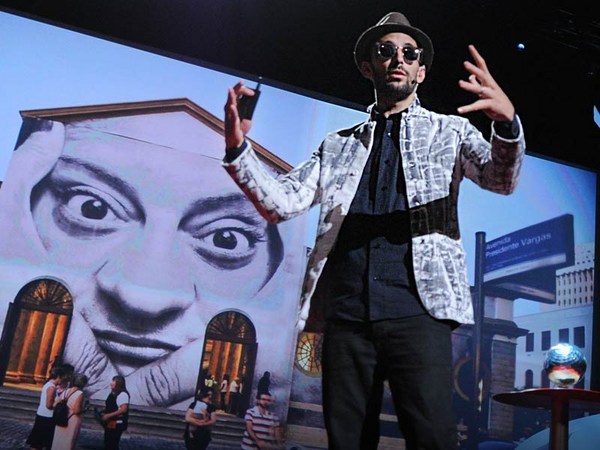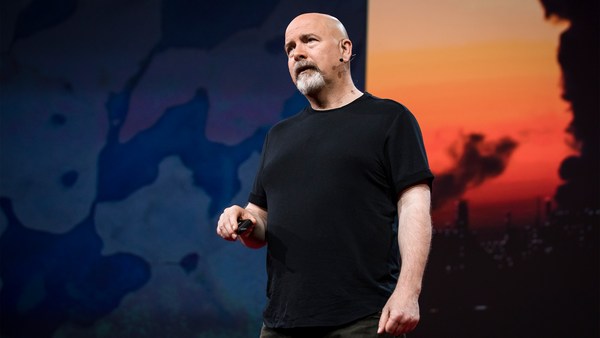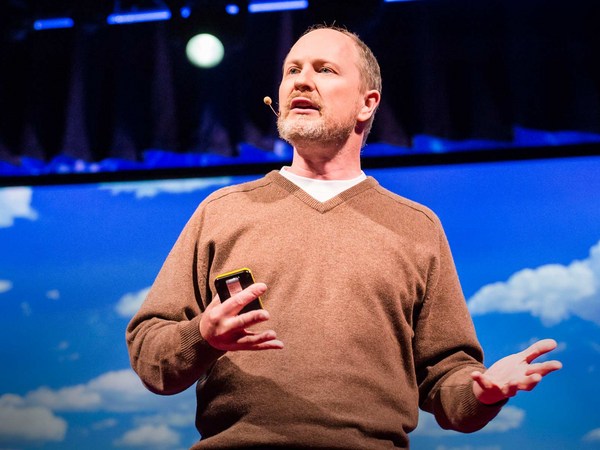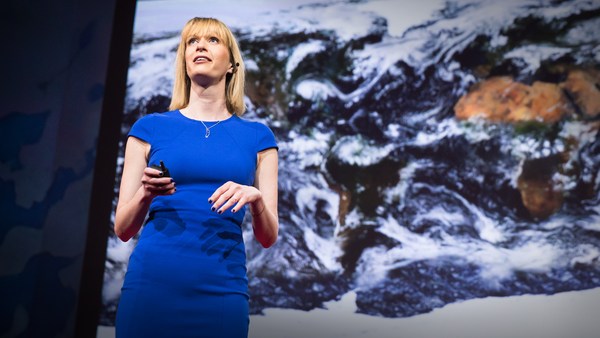This is my favorite place on earth, Salar de Uyuni in Bolivia. And when it's covered in a thin layer of water, it reflects the clouds. There are days when you feel as if you're floating among the clouds. But there are days when the horizon disappears; there's no longer a top or a bottom. You feel immersed in something bigger.
It was there that one night I woke up from a dream, and I saw that the stars were also reflected on the water. And that wasn't a dream. It was as if you could walk among the stars. With every step I took, the stars reverberated under my feet. It was like I was floating in the universe among clouds of galaxies.
But what's floating there today are not just clouds of galaxies but also clouds of plastic. These are the footprints we're leaving on the planet. They're signs of an era in which the behavior of some humans is making a global impact on our ecosystems. This era is called the Anthropocene. There's also another type of toxic clouds that float in the air, like the ones that form from carbon dioxide emissions and from the burning of fossil fuels -- oil, carbon, gas -- clouds that, when we see them, pollute our dreams. I don't know about all of you, but I've always dreamed of floating among the clouds. Maybe today we can imagine together other types of clouds, clouds we can live with.
If you're wondering about that photo, I'll explain: it looks like a collage or photomontage -- something weird. No; it's reality. But sometimes I ask myself: What is reality? According to Alexander Kluge: "Human beings are not interested in reality. They can’t be; it’s part of the human essence. They have desires. These desires are totally opposed to any form of reality. They prefer to lie than to become divorced from their desires." But how can we learn to float among the clouds? As an artist, I thought we could start building a flying museum. You're probably wondering: With plastic bags?
In 2007, with a community of people all over the world, we began to collect used plastic bags -- not new ones. And we washed them, we cut them up, we glued them together, and we began to draw on them, creating a huge canvas. We made a collection of drawings, of personal stories and of friendships. And when you join them, bend them and fold them, it creates a space full of air. When the sun comes up from the horizon, the museum rises up to the sky. That's why we call it, "The Aero-Solar Museum." And from this simple idea, we learned how to float in the air in a radically new way, without using any type of fuel. The difference in temperature between the interior and the exterior is what makes us rise up. That way, we don't use fossil fuels or helium or hydrogen; we don't use solar panels or batteries or motors. We discovered a way that's simple, clean and accessible to the whole world to lift ourselves up.
I remember when I was at NASA in 2009 with 120 engineers. You guys know, too, when you go up in a plane, the control panels are gigantic. And what we're doing is really complex, and when I started coming in with the plastic bags, saying, "But we have a different way ..." people had a hard time understanding the concept. Seeing the power of this idea, we started to initiate a new era; one that would leave behind the violence of the Anthropocene and give way to a new era, which we call the "Aerocene" -- an era of ecological awareness, in which we learn to float together, live together in the air, and come to an ethical commitment with the atmosphere and with planet earth. That's why I've brought this backpack today. Let's see ...
OK. This is a balloon that we also refer to as a sculpture. And if it's sunny out tomorrow, we can go out and fly -- though, no, the weather in Vancouver isn't --
(Laughter)
it's not very ... very favorable.
So, what other features does it have? It has sensors that, when it moves, make sort of drawings in the air. It also has other sensors. I always think that first you have to feel it, and then you can measure it; you need to hear the sounds of the atmosphere, of the climate, of the hot air, in order to then measure the ozone, the carbon dioxide. We're developing these sensors together with different communities all over the world in order to reconnect with the climate, the temperature and the environment, because there are other species in the air; in these excursions towards the atmosphere, we're not alone. The air is full of clouds of life. We live at the bottom of an ocean of air.
And this same sculpture, this exact one in my hands, flew 375 miles -- 12 hours -- from Germany to Poland, on a fuel-free trip. But it wasn't free from crossing borders. The trip was much more complicated than what we imagined; air space is as regulated and militarized as land space. To fly using the winds, the heat of the sun and the radiant energy of the earth is complex and beautiful. But even more complex will be getting the permits to cross the air space of each of the different countries that we fly over using wind.
At COP21, the Paris Climate Conference, we presented these spherical sculptures that could transport us all over the world. But how can we fly using the wind to arrive at our destination? Together with MIT, we developed a program that predicts how we can navigate the wind highways. For example, if I had to return to Berlin from Vancouver, the first thing I would need to do is choose an altitude. At different altitudes, there are different directions and different speeds. The red line is tomorrow and the orange, the day after tomorrow. And there it goes. You can see, the best day to fly back to Berlin -- so now, traveling using only wind -- is in six days. And we can get to 105 miles from the center of Berlin without burning a single drop of fuel, being transported only by wind currents.
So we thought that these trajectories that we drew with the wind could become signatures, declaring "Independence from Fossil Fuels Day." More and more of us are experiencing the air in a different way. You're all familiar with Earth Day. We think we should also celebrate Air Day: it's a pact that we make with the earth, an ethical commitment to the atmosphere. But let's keep thinking and dreaming.
We've learned that the bigger the sculptures are, the more weight they can lift. Remember, they rise up only with hot air that's been heated by the sun. Using this approach, we can learn to build gardens in the air. Could we one day live in a garden the size of the earth? Could we live in an ecosystem floating among the clouds? Answering these questions isn't just a technological challenge; it's a way to reexamine the freedom of movement between countries, and of overcoming the political, social, cultural and military restrictions of contemporary societies. Because in the end, the air belongs to everybody and doesn't answer to any government.
(Applause)
And like we said earlier, our imagination is the force that allows us to create these places.
This is an installation I did at the Metropolitan Museum of Art in New York. It asks the question: What might these transnational spaces be like? And once we inhabit those spaces, we need to learn how to move within them, to walk among the clouds, where every movement affects everyone else's movements; the body weight and proximity between people will cause the space to expand ... or contract. There we are, suspended 72 feet in the air. When two or more people get too close together, even those farthest away are affected -- everyone falls to the same spot. These are fragile ecosystems. And it's between these spheres that we build nets that connect us. There are moments when we have to face the void, and fear can paralyze us. One of the most beautiful things about this exhibit is the sense of solidarity generated when we face these new "aero-graphs."
Finally, let me tell you one last story. On July 16, 1945, on the White Sands of New Mexico, an atomic bomb was detonated for the first time. As a result of this explosion, a cloud of radioactive particles disseminated all over the earth, marking the beginning of the Anthropocene era. Seventy years later, on November 8, 2015, in the same place, another event occurred. For the first time in history, we lifted a person into the air using only the sun, without burning any fossil fuels. As the sun rose up above the horizon, we rose up, too, silently, slowly, with no explosions. We felt as if gravity had been inverted; it wasn't pulling us toward the center of the earth, but toward the universe. If Neil Armstrong said, when he walked on the moon, "That's one small step for man, one giant leap for mankind," perhaps what we ought to ask ourselves is: What steps do we need to take today?
In the Aerocene era, our steps are much smaller, but radically different; they're steps that began with a bag full of air and wishes, but that can carry us to independence from fossil fuels and the opportunity to celebrate Air Day; steps that won't leave footprints on other planets until we've learned to walk in the atmosphere of this one. The landscapes are tiny and the steps are tiny, but I hope we can take them together. And I'm sure that these steps will lead us much further than the moon, so we can learn to float with our feet on the ground.
Thank you.
(Applause)





